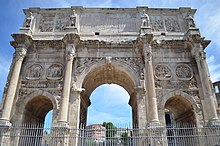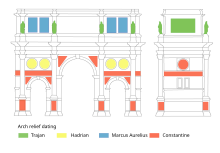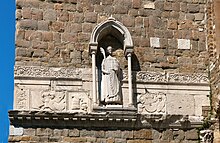348:
22:
396:
325:
267:
306:
412:
185:
287:
372:
87:
347:
442:
75:
201:
the renovation of past imperial glories). Pragmatic readings emphasize the utility of re-used materials: if there is a good supply of old marble columns available, for example, there is no need to produce new ones. The two approaches are not mutually exclusive, and there is certainly no one approach that can account for all instances of spoliation, as each instance must be evaluated within its particular historical context.
58:) whereby stone that has been quarried, cut and used in a built structure is carried away to be used elsewhere. The practice is of particular interest to historians, archaeologists and architectural historians since the gravestones, monuments and architectural fragments of antiquity are frequently found embedded in structures built centuries or millennia later. The archaeologist
200:
generally alternate between the "ideological" and the "pragmatic". Ideological readings might describe the re-use of art and architectural elements from former empires or dynasties as triumphant (that is, literally as the display of "spoils" or "booty" of the conquered) or as revivalist (proclaiming
98:. Entire structures, including underground foundations, are known to have been demolished to enable the construction of new ones. According to Baxter, two churches in Worcester (one 7th century and one 10th) are thought to have been deconstructed so that their building stone could be repurposed by
244:: "laying a statue on its side places it and the power it represents under control. It is a way of acquiring the power of rival gods for one's own benefit", James observes. "Inscribing a cross works similarly, sealing the object for Christian purposes".
223:
that lurked in stones that had been consecrated to pagan usage. Liz James extends Foss's observation in noting that statues, laid on their sides and facing outwards, were carefully incorporated in Ankara's city walls in the 7th century, at a time when
411:
964:
266:
21:
953:
66:
that could be seen to have been cut down and undergone weathering while it was in use as part of an exterior wall and, possibly as late as the 5th century, reinscribed for reuse as a tombstone.
181:
is primarily concerned with these and other medieval examples, the practice is common and there is probably no period of art history in which evidence for "spoliation" could not be found.
846:
B. Kiilerich, "Antiquus et modernus: Spolia in
Medieval Art - Western, Byzantine and Islamic", in Medioevo: il tempo degli antichi, ed. A.C. Quintavalle, Milan 2006,135-145.
395:
54:) are stones taken from an old structure and repurposed for new construction or decorative purposes. It is the result of an ancient and widespread practice (
371:
948:
H.-R. Meier, "Vom
Siegeszeichen zum Lüftungsschacht: Spolien als Erinnerungsträger in der Architektur," in: Hans-Rudolf Meier und Marion Wohlleben (eds.),
305:
324:
247:
There has been considerable controversy over the use of Jewish gravestones as pavement materials in several
Eastern European countries during and after
657:
286:
1021:
992:
Spolien: Untersuchungen zur Übertragung von
Bauteilen und ihr politischer Symbolgehalt am Beispiel von St-Denis, Aachen und Magdeburg
469:
786:
J. Elsner, "From the
Culture of Spolia to the Cult of Relics: The Arch of Constantine and the Genesis of Late Antique Forms,"
843:
B. Kiilerich, "Making Sense of the Spolia in the Little
Metropolis in Athens," 'Arte medievale n.s. anno IV, 2, 2005, 95–114.
697:
252:
211:
spiritual value. Clive Foss has noted that in the 5th century crosses were inscribed on the stones of pagan buildings, as at
591:
624:
916:
P. Liverani, "Reimpiego senza ideologia: la lettura antica degli spolia dall’arco di
Costantino all’età carolingia,"
1031:
959:
M. Muehlbauer, "From Stone to Dust: The Life of the Kufic
Inscribed Frieze of Wuqro Cherqos in Tigray, Ethiopia,"
800:
F.B. Flood, "The
Medieval Trophy as an Art Historical Trope: Coptic and Byzantine 'Altars' in Islamic Contexts,"
417:
1006:
From
Classical Antiquity to the Middle Ages: Urban Public Building in Northern and Central Italy A.D. 300–850
130:
556:
James, "'Pray Not to Fall into Temptation and Be on Your Guard': Pagan Statues in Christian Constantinople"
719:
J. Alchermes, "Spolia in Roman Cities of the Late Empire: Legislative Rationales and Architectural Reuse,"
441:
830:
665:
715:
There is a large modern literature on spolia, and the following list makes no claim to be comprehensive.
273:
216:
503:– armour and arms a Roman general stripped from the body of an opposing commander slain in single combat
793:
A. Esch, "Spolien: Zum Wiederverwendung antike Baustücke und Skulpturen in mittelalterlichen Italien,"
362:
464:
154:
150:
938:, in "Rivista dell’Istituto Nazionale di Archeologia e storia dell’Arte",13. 1990, pp. 119–138.
819:
1036:
983:
H. Saradi, "The Use of Spolia in Byzantine Monuments: the Archaeological and Literary Evidence,"
838:
The eloquence of appropriation: prolegomena to an understanding of spolia in early Christian Rome
768:, "Columpnas marmoreas et lapides antiquarum ecclesiarum: The Use of Spolia in the Churches of
489:
115:
687:
864:
421:
382:
829:(Settimane di Studi del Centro Italiano di Studi sull'Alto Medioevo 46), (Spoleto, 1999). (
184:
170:
99:
8:
874:
868:
769:
142:
126:
79:
353:
18th-century illustration of a Roman statue and inscriptions reused in the walls of the
1026:
997:
S. Settis, “Continuità, distanza, conoscenza: tre usi dell’antico,” in S. Settis, ed.,
950:
Bauten und Orte als Träger von Erinnerung: Die Erinnerungsdebatte und die Denkmalpflege
856:
D. Kinney, "Rape or Restitution of the Past? Interpreting Spolia," in S.C. Scott, ed.,
765:
334:
693:
632:
599:
354:
189:
134:
208:
59:
30:
740:
B. Brenk, "Spolia from Constantine to Charlemagne: Aesthetics versus Ideology,"
735:
The power of tradition: Spolia in the architecture of St. Peter's in the Vatican
433:
429:
95:
86:
62:
gives the example of a late Roman period (probably 1st-century) tombstone from
29:
capital embedded in the south wall of the Church of St. Peter at Ennea Pyrgoi,
825:
M. Greenhalgh, "Spolia in fortifications: Turkey, Syria and North Africa," in
492:– a Roman Imperial palace in Split, re-purposed by later inhabitants as a town
1015:
943:
Byzantine East, Latin West. Art Historical Studies in Honor of Kurt Weitzmann
849:
D. Kinney, "Spolia from the Baths of Caracalla in Sta. Maria in Trastevere,"
755:
636:
603:
451:
248:
212:
122:
500:
277:
133:; examples in Byzantine territories include the exterior sculpture on the
971:
Spolien und Trophäen im mittelalterlichen Genua: sic hostes Ianua frangit
774:
Arte d'Occidente: temi e metodi. Studi in onore di Angiola Maria Romanini
311:
111:
26:
479:
146:
978:
Antike Spolien in der Architektur des Mittelalters und der Renaissance
941:
C. Mango, "Ancient Spolia in the Great Palace of Constantinople," in
904:
A Companion to Medieval Art: Romanesque and Gothic in Northern Europe
572:
James 1996, noting O. Hjort, "Augustus Christianus—Livia Christiana:
495:
162:
580:(Transactions of the Swedish Institute in Istanbul, IV) 1993:93–112.
470:
Roman Empire#Tetrarchy (285–324) and Constantine the Great (324–337)
952:(Zürich: Institut für Denkmalpflege der ETH Zürich, 2000), 87–98. (
936:
Vicende del Tempio di venere e Roma nel medioevo e nel Rinascimento
689:
The Walls of Jerusalem: Preserving the Past, Controlling the Future
474:
241:
174:
166:
107:
63:
296:
74:
809:
Spolia in Fortifications and the Common Builder in Late Antiquity
338:
237:
229:
576:
and Roman portrait sculpture", in L. Ryden and J.O. Rosenqvist,
361:, Malta. The statue has since been removed and it is now in the
483:
425:
233:
220:
138:
103:
272:
Fragments of Greek inscriptions in the masonry of the Ottoman
386:
315:
219:. Foss suggests that the purpose of this was to ward off the
102:
to construct a cathedral in 1084. And the parish churches of
43:
402:
358:
863:
D. Kinney, "Making Mute Stones Speak: Reading Columns in
161:
in the medieval Islamic world include the columns in the
911:
Spolia: uso e rempiego dell'antico dal III al XIV secolo
902:
D. Kinney, "The concept of Spolia," in C. Rudolph, ed.,
114:
are largely built of stone taken from the buildings of
881:
D. Kinney, "Spolia. Damnatio and renovatio memoriae,"
827:
Ideologie e pratiche del reimpiego nell'alto medioevo
816:
The Survival of Roman Antiquities in the Middle Ages
482:– the practice of erasing old texts from scarce old
215:, where crosses were inscribed on the walls of the
141:); in the medieval West Roman tiles were reused in
890:Proceedings of the American Philosophical Society
1013:
985:International Journal of the Classical Tradition
90:Dating of the reliefs on the Arch of Constantine
728:The urban image of late antique Constantinople
16:Repurposed building stone for new construction
578:Aspects of Late Antiquity and Early Byzantium
125:, the earlier imperial reliefs reused on the
592:"U.S. Prods to Reclaim Holocaust Cemeteries"
401:Jewish headstones used as part of a wall in
540:Foss, "Late Antique and Byzantine Ankara"
145:, in much of the medieval architecture of
888:D. Kinney, "Roman Architectural Spolia,"
781:Die Spolien in der spätantike Architektur
228:were also being built into city walls in
94:The practice of spoliation was common in
895:D. Kinney, "Spolia," in W. Tronzo, ed.,
521:
519:
517:
183:
85:
73:
20:
883:Memoirs of the American Academy in Rome
685:
625:"Restoring a Jewish Cemetery in Poland"
589:
528:Techniques of Archaeological Excavation
153:, and the colonnade of the basilica of
1014:
999:Memoria dell’antico nell’arte italiana
976:J. Poeschke and H. Brandenburg, eds.,
692:. John Wiley & Sons. p. 162.
655:
525:
514:
47:
1022:Ancient Roman architectural elements
788:Papers of the British School at Rome
622:
177:. Although the modern literature on
873:Architectural Studies in Memory of
658:"Saving Cemeteries Here And Abroad"
13:
710:
623:Hahn, Avital Louria (1997-09-14).
428:, Italy, looted by Venetians from
14:
1048:
754:R. Brilliant, "I piedistalli del
314:column incorporated into a wall,
440:
410:
394:
370:
346:
323:
304:
285:
265:
860:(University Park, 1995), 52–67.
758:: spolia in se, spolia in re,"
679:
649:
616:
583:
566:
550:
534:
418:Portrait of the Four Tetrarchs
253:their rule over East Jerusalem
251:, as well as by Jordan during
1:
994:(M.A. thesis, Bamberg, 1999).
590:Musleah, Rahel (1995-11-26).
507:
1001:(Torino, 1985), III.373–486.
747:B. Brenk, "Sugers Spolien,"
656:Lipman, Steve (2003-05-16).
276:(Yedikule) fortress (1431),
7:
458:
217:Temple of Augustus and Rome
121:Roman examples include the
69:
10:
1053:
945:(Princeton, 1995), 645–57.
897:St. Peter's in the Vatican
795:Archiv für Kunstgeschichte
526:Barker, A. Philip (1977).
363:Gozo Museum of Archaeology
335:Ravenna Baptistery of Neon
258:
149:, porphyry columns in the
131:Old Saint Peter's Basilica
899:(Cambridge, 2005), 16–47.
871:," in C.L. Striker, ed.,
465:Crisis of the 3rd Century
155:Santa Maria in Trastevere
151:Palatine Chapel in Aachen
530:. Routledge. p. 11.
1032:Latin words and phrases
906:(Oxford, 2006), 233–52.
858:The Art of Interpreting
299:, Turkey, at Lefke Gate
929:Res Publica Litterarum
686:Balfour, Alan (2019).
563:.1 (1996:12–20) p. 16.
193:
116:Viroconium Cornoviorum
91:
83:
34:
918:Römische Mitteilungen
878:(Mainz, 1996), 83–86.
836:M. Fabricius Hansen,
833:, provided by author)
822:, provided by author)
776:(Rome, 1999), 187–95.
742:Dumbarton Oaks Papers
721:Dumbarton Oaks Papers
542:Dumbarton Oaks Papers
383:Church of St. Donatus
381:in the foundation of
187:
89:
77:
24:
920:111 (2004), 383–434.
892:145 (2001), 138–161.
865:S. Nicola in Carcere
295:in the city wall of
135:Panagia Gorgoepikoos
885:42 (1997), 117–148.
875:Richard Krautheimer
770:Charles II of Anjou
490:Diocletian's Palace
196:Interpretations of
143:St Albans Cathedral
129:, the colonnade of
127:Arch of Constantine
80:Arch of Constantine
987:3 (1997), 395–423.
853:68 (1986), 379–97.
790:68 (2000), 149–84.
756:giardino di Boboli
751:1 (1983), 101–107.
744:41 (1987), 103–09.
737:(Hilversum, 2004).
730:(Cambridge, 2004).
723:48 (1994), 167–78.
629:The New York Times
596:The New York Times
422:St Mark's Basilica
194:
188:Bell tower of the
92:
84:
35:
1004:B. Ward-Perkins,
990:Annette Schäfer,
931:20 (1997), 83–94.
818:(London, 1989). (
699:978-1-119-18229-0
486:to write new text
420:in the corner of
190:Trieste Cathedral
1044:
963:38 (2021), 1-34.
909:L. de Lachenal,
869:S. Maria Antiqua
831:Available online
820:Available online
797:51 (1969), 2–64.
779:F.W. Deichmann,
762:31 (1982), 2–17.
704:
703:
683:
677:
676:
674:
673:
664:. Archived from
653:
647:
646:
644:
643:
620:
614:
613:
611:
610:
587:
581:
570:
564:
554:
548:
538:
532:
531:
523:
444:
414:
398:
374:
350:
327:
308:
289:
269:
60:Philip A. Barker
49:
31:Kalyvia Thorikou
1052:
1051:
1047:
1046:
1045:
1043:
1042:
1041:
1012:
1011:
980:(Munich, 1996).
973:(Weimar, 2002).
934:S. Lorenzatti,
814:M. Greenhalgh,
783:(Munich, 1975).
713:
711:Further reading
708:
707:
700:
684:
680:
671:
669:
654:
650:
641:
639:
621:
617:
608:
606:
588:
584:
571:
567:
555:
551:
539:
535:
524:
515:
510:
461:
454:
445:
436:
415:
406:
399:
390:
375:
366:
351:
342:
328:
319:
309:
300:
290:
281:
270:
261:
72:
17:
12:
11:
5:
1050:
1040:
1039:
1037:Building stone
1034:
1029:
1024:
1010:
1009:
1008:(Oxford, 1984)
1002:
995:
988:
981:
974:
967:
957:
946:
939:
932:
927:as Property,"
921:
914:
913:(Milan, 1995).
907:
900:
893:
886:
879:
861:
854:
847:
844:
841:
834:
823:
812:
811:(Leiden, 2016)
805:
798:
791:
784:
777:
763:
752:
749:Arte Medievale
745:
738:
731:
724:
712:
709:
706:
705:
698:
678:
648:
615:
582:
565:
549:
533:
512:
511:
509:
506:
505:
504:
498:
493:
487:
477:
472:
467:
460:
457:
456:
455:
446:
439:
437:
434:Fourth Crusade
430:Constantinople
416:
409:
407:
400:
393:
391:
376:
369:
367:
352:
345:
343:
329:
322:
320:
310:
303:
301:
291:
284:
282:
271:
264:
260:
257:
96:late antiquity
71:
68:
46:for 'spoils';
15:
9:
6:
4:
3:
2:
1049:
1038:
1035:
1033:
1030:
1028:
1025:
1023:
1020:
1019:
1017:
1007:
1003:
1000:
996:
993:
989:
986:
982:
979:
975:
972:
968:
966:
962:
958:
955:
951:
947:
944:
940:
937:
933:
930:
926:
922:
919:
915:
912:
908:
905:
901:
898:
894:
891:
887:
884:
880:
877:
876:
870:
866:
862:
859:
855:
852:
848:
845:
842:
840:(Rome, 2003).
839:
835:
832:
828:
824:
821:
817:
813:
810:
806:
803:
799:
796:
792:
789:
785:
782:
778:
775:
771:
767:
764:
761:
757:
753:
750:
746:
743:
739:
736:
732:
729:
725:
722:
718:
717:
716:
701:
695:
691:
690:
682:
668:on 2022-01-28
667:
663:
659:
652:
638:
634:
630:
626:
619:
605:
601:
597:
593:
586:
579:
575:
569:
562:
559:
553:
546:
543:
537:
529:
522:
520:
518:
513:
502:
499:
497:
494:
491:
488:
485:
481:
478:
476:
473:
471:
468:
466:
463:
462:
453:
452:Patras Castle
449:
443:
438:
435:
431:
427:
423:
419:
413:
408:
404:
397:
392:
388:
384:
380:
373:
368:
364:
360:
356:
349:
344:
340:
336:
332:
326:
321:
317:
313:
307:
302:
298:
294:
288:
283:
279:
275:
268:
263:
262:
256:
254:
250:
249:The Holocaust
245:
243:
239:
235:
231:
227:
222:
218:
214:
210:
206:
202:
199:
191:
186:
182:
180:
176:
172:
168:
164:
160:
156:
152:
148:
144:
140:
136:
132:
128:
124:
123:Arch of Janus
119:
117:
113:
109:
105:
101:
97:
88:
81:
76:
67:
65:
61:
57:
53:
45:
41:
40:
32:
28:
23:
19:
1005:
998:
991:
984:
977:
970:
960:
949:
942:
935:
928:
924:
917:
910:
903:
896:
889:
882:
872:
857:
851:Art Bulletin
850:
837:
826:
815:
808:
801:
794:
787:
780:
773:
766:C. Bruzelius
759:
748:
741:
734:
727:
726:S. Bassett,
720:
714:
688:
681:
670:. Retrieved
666:the original
661:
651:
640:. Retrieved
628:
618:
607:. Retrieved
595:
585:
577:
573:
568:
560:
557:
552:
544:
541:
536:
527:
501:Spolia opima
447:
378:
330:
292:
278:Thessaloniki
274:Heptapyrgion
246:
225:
204:
203:
197:
195:
178:
158:
120:
93:
55:
51:
38:
37:
36:
18:
969:R. Müller,
923:J. Lomax, "
807:J.M. Frey,
760:Prospettiva
733:L. Bosman,
662:Jewish Week
432:during the
312:Ionic order
165:mosques of
112:Upton Magna
100:St. Wulstan
1016:Categories
804:18 (2001).
672:2023-07-05
642:2023-07-05
609:2023-07-05
547:(1977:65).
508:References
480:Palimpsest
355:Cittadella
209:apotropaic
147:Colchester
137:church in
56:spoliation
1027:Recycling
637:0362-4331
604:0362-4331
496:Slighting
450:from the
405:, Ukraine
389:, Croatia
163:hypostyle
961:Muqarnas
802:Muqarnas
574:Sphragis
475:Dominate
459:See also
280:, Greece
242:Pergamum
221:daimones
167:Kairouan
108:Wroxeter
70:Overview
64:Wroxeter
33:, Greece
341:, Italy
339:Ravenna
318:, Syria
259:Gallery
238:Ephesus
230:Miletus
192:, Italy
175:Cordoba
82:in Rome
52:spolium
925:Spolia
772:," in
696:
635:
602:
484:vellum
448:Spolia
426:Venice
379:spolia
377:Roman
331:Spolia
293:Spolia
234:Sardis
226:spolia
213:Ankara
205:Spolia
198:spolia
179:spolia
159:Spolia
139:Athens
110:, and
104:Atcham
39:Spolia
558:Gesta
424:, in
387:Zadar
316:Bosra
297:İznik
44:Latin
27:Ionic
867:and
694:ISBN
633:ISSN
600:ISSN
403:Lviv
359:Gozo
240:and
207:had
173:and
171:Gaza
78:The
965:PDF
954:pdf
385:in
333:at
48:sg.
25:An
1018::
660:.
631:.
627:.
598:.
594:.
561:35
545:31
516:^
357:,
337:,
255:.
236:,
232:,
169:,
157:.
118:.
106:,
50::
956:)
702:.
675:.
645:.
612:.
365:.
42:(
Text is available under the Creative Commons Attribution-ShareAlike License. Additional terms may apply.



